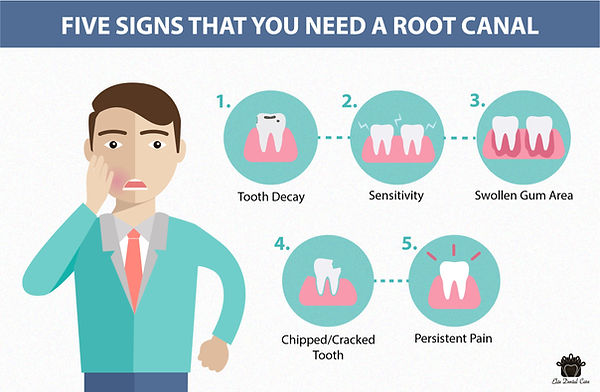Root canal
Dental nerves need to be removed whenever they are infected or exposed to possible infection. A large cavity or fracture, for example, can compromise your tooth's vitality. Besides, if your tooth is in intense pain, severely damaged, or stained, then there's a good possibility you'll need a root canal.
Root canal therapy is the removal of the nerve from the inside of the tooth due to the tooth being badly damaged from decay, disease or injury. Treatment is required if the tooth becomes infected or inflamed. The aim of the treatment is to save the tooth. Without treatment the tissue surrounding the tooth may become infected and an abscess may form.
Some of this Signs you may need root canal therapy include Severe tooth pain upon chewing or application of pressure, Prolonged sensitivity (pain) to hot or cold temperatures (after the heat or cold has been removed), Discoloration (darkening) of the tooth., Swelling and tenderness in nearby gums.
Source
Why to remove the nerve from the tooth?
Root canal treatment is replacing a tooth’s damaged or infected nerve with a filling. If the nerve is not removed:
-
It becomes infected; it loses its ability to fight the spread of the infection. This can cause a severe infection or an abscess which can spread into the surrounding bone
-
The infection may spread around the ends of the infected root and cause bone loss in the jaw.
-
The tooth may need to be removed (extracted)
-
The infection may cause swelling that may spread to other areas of the face, neck, or head
How can the tooth’s nerve be damaged?
The tooth’s nerve can become infected or inflamed if:
-
there is decay beneath a deep filling or crown
-
there is deep-seated and untreated dental decay
-
the tooth has experienced trauma
-
gum disease is present
-
there is a crack or chip in the tooth
-
there is extreme wear from habitual tooth grinding (bruxism)
-
there is advanced gum disease
What are the possible symptoms?
Sometimes there may be no symptoms evident. But the symptoms that may indicate a problem with the tooth are
-
Severe pain upon chewing or application of pressure
-
Prolonged pain after eating/drinking something hot or cold
-
Discoloration (a darkening) of the tooth
-
Swelling and soreness in the gums surrounding the tooth
-
A persistent or recurring pimple on the gum
-
Unprovoked or spontaneous pain
Myths About Root canal
Advantage of root canal therapy
⦁ Relief from debilitating pain, including the discomfort.
⦁ Prevention of infection spreading, and damage to the oral bone.
⦁ It’s a more affordable alternative to reinstating the tooth with an implant.
⦁ After the initial pain of getting practiced to a crown, it is more cosmetically appealing because it’s natural-looking.
⦁ The most straightforward but most important logic to get a root canal alternatively of extraction is that you get to keep your tooth.
Though it may be dead, this process is still beneficial as this allows you to continue to eat and speak as you usually do since extracting the tooth can affect both.
Now you know the know-how on root canals, so you don't have to be worried if you need one. There are lots of myths out there on root canals. But the fact is that they're super practical, surprisingly not painful, also can save your teeth from being extracted
Contact Bright Smile Dental Clinic as soon as possible if you notice any root canal-related symptoms, like sensitivity to hot and cold or pimples on gums. It's necessary to get treated if you need a root canal, so don't wait. You'll be glad to get the help you need. Plus, you'll become a living legend to debunk the myths of root canals.
After the Procedure
Taking good care of your teeth & gums is a necessity after a root canal treatment. You might need to schedule an additional visit at us to X-ray the treated tooth moreover ensure that all signs of infection are gone. In addition, twice a year, dental cleanings and examinations are advised. Ultimately, it is essential to keep up a good oral care routine at home, including brushing twice a day with toothpaste, which helps lock in calcium in teeth and protects them from cavities. With care and attention, a diseased tooth treated with root canal therapy can stay healthy for the rest of your life.




